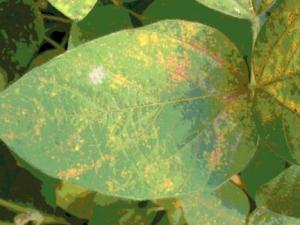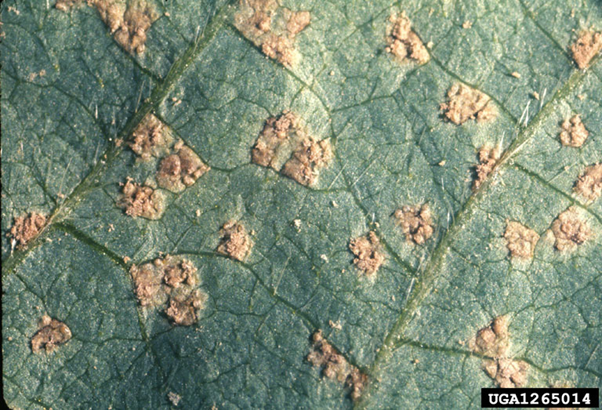Soybean rust is a destructive foliar disease of soybean. it was first reported in the Eastern Hemisphere in the early 1900s. It is now accepted that there are two different fungal species, Phakopsora pachyrhizi and Phakopsora meibomiae, that cause soybean rust. Phakopsora meibomiae, referred to as the New World type, is a much weaker pathogen and is the pathogen that has been found in the Western Hemisphere
Asian soybean rust also called Australasian soybean rust is caused by the fungus Phakopsora pachyrhizi,. It is an aggressive disease that destroys photosynthetic tissue, causing premature defoliation, early maturation, and lower yields. The fungus requires a living host to survive. The soybean plant is susceptible to rust infection at all growth stages, and typically develops in the lower canopy on older leaves first during periods of high humidity. symptoms are most common during and after flowering. The disease usually starts within the low to mid canopy and moves up the plant
Early symptoms of rust infection begin on the lower leaves deep in the canopy as small spots that increase in size and change from gray to tan or reddish brown usually on the lower leaf surfaces. On the upper leaf surface, initial symptoms may be small and yellow, these lesions darken and may range from dark brown or reddish brown to tan or gray-green in color
Especially at the early stages, it is easy to confuse the symptoms of soybean rust with symptoms of three other soybean leaf diseases: brown spot caused by the fungus, Septoria gycines; bacterial pustule, caused by Xanthomonas axonopodis pv. glycines; and bacterial blight (also called angular leaf spot), caused by Pseudomonas savastanoi pv. glycinea. Later in the season soybean rust may be confused with Cercospora leaf spot or sunburn, which also turns the leaves a bronze color.
Extended periods of cool, wet weather during the growing season would favor soybean rust epidemics. Rust pustules appear on the leaf surface 9 to 10 days after infection, and spores are usually evident soon after. Each lesion can produce vast numbers of spores and spore production may continue for weeks. The combination of high spore production and successful long-distance spore spread allows soybean rust to build-up rapidly and makes it a difficult pathogen to control.


.png?height=120&name=AgroScout_logo_Big_High_Resolution-(1).png)